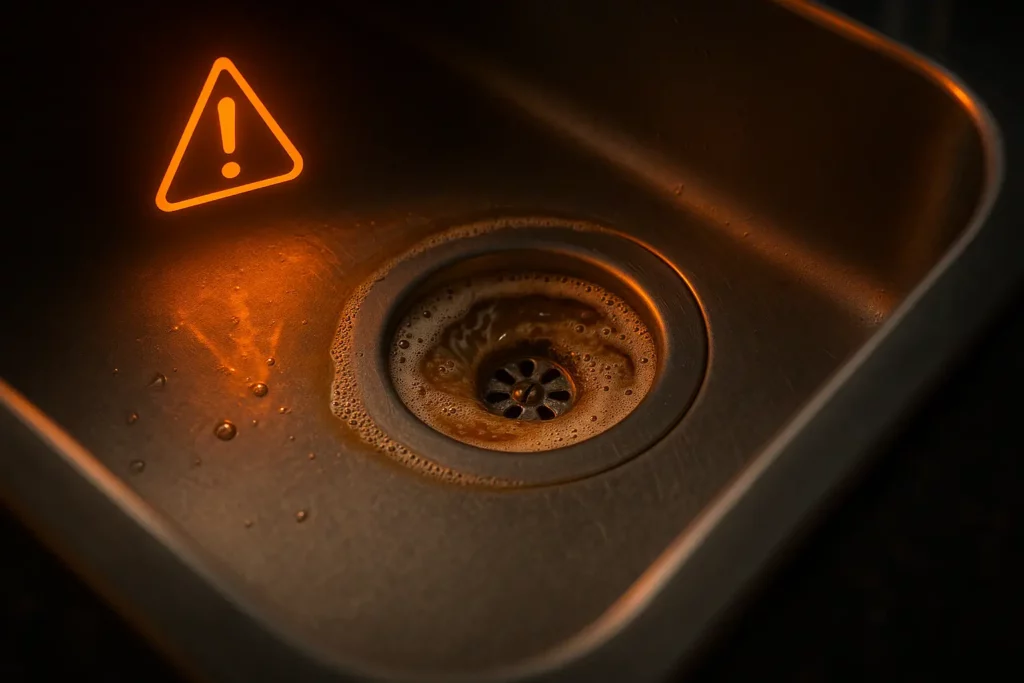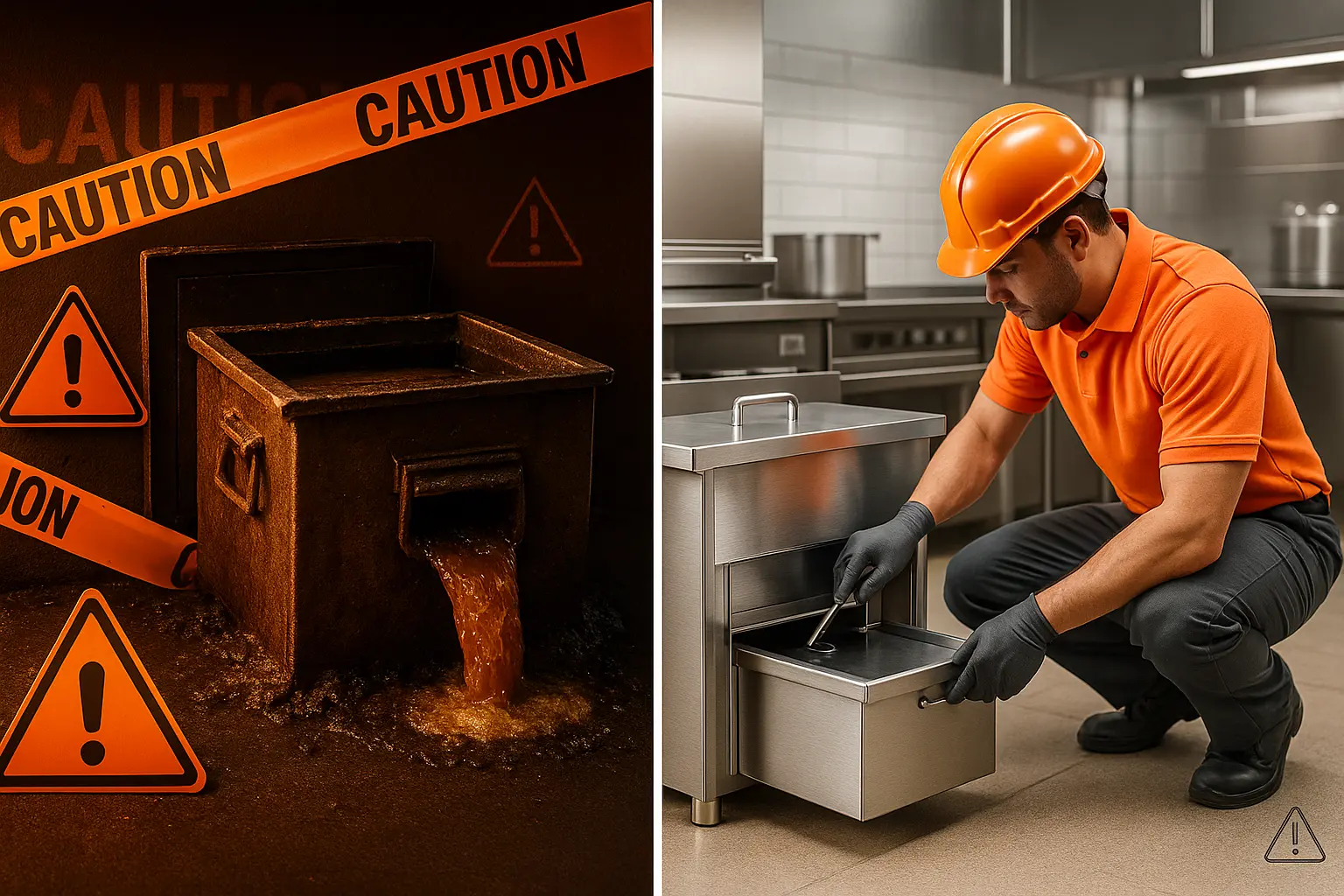Jump to answers:
How often does a grease trap need to be emptied?
Empty your restaurant grease trap every 1-3 months based on usage. Many cities require cleaning grease traps every 90 days regardless of fill level.
High-volume commercial kitchens frying daily need monthly grease trap maintenance. Smaller cafes might stretch quarterly cleaning if their grease trap handles less food waste. Manual grease trap systems demand more frequent attention than automatic grease traps with self-cleaning features.
Your local health department sets grease trap regulations. Some jurisdictions mandate that traps should be cleaned every 90 days—period. Others allow the 25% capacity rule to dictate your grease trap cleaning schedule.
DO: ✓ Check local regulations for grease trap requirements ✓ Schedule cleaning based on YOUR grease volume ✓ Keep 3 years of grease trap cleaning records ✓ Train staff on proper disposal methods
DON’T: ✗ Wait for grease trap problems to appear ✗ Assume one cleaning schedule fits all restaurants ✗ Skip documentation of maintenance
When FOG accumulates, it restricts water flow through your grease trap and creates stubborn clogs. Overwhelmed grease traps lead to wastewater flooding commercial kitchens with contamination. Emergency grease trap work by licensed plumbers costs 3x more than scheduled professional service.
“I thought quarterly grease trap cleaning was enough until sewage backed up during Saturday dinner rush. Lost $8,000 that night alone.” – Restaurant owner, Atlanta
⚠️ Penalty breakdown for grease trap violations:
- First violation: $1,000 minimum
- Repeat offenses: Up to $10,000
- Environmental damage: Criminal charges
- Non-compliance: Immediate closure
Summary: Most restaurant grease traps need emptying every 1-3 months, but follow your city’s rules—many require 90-day service regardless. High-volume kitchens may need monthly cleaning while smaller operations can stretch to quarterly.

Jorge Argota
How often does a grease trap need to be serviced?

Service your grease trap at 25% capacity or monthly for busy commercial kitchens. Include component inspections beyond just pumping fats, oils and grease.
Professional grease trap servicing means more than emptying FOG from the tank. Technicians inspect baffles, gaskets, and pipes during the cleaning process. They catch problems before expensive grease trap failures hit your restaurant.
Thorough grease trap cleaning eliminates all residue causing foul odors throughout your kitchen. Crews wear protective gear (including nose plugs for intense smells) while using specialized vacuum tools. High-pressure water lines blast away debris that manual cleaning methods miss.
“Our dishwasher kept backing up until we switched from basic pumping to full grease trap cleaning service. Haven’t had issues in two years now.” – Chef, Miami
Kitchen grease trap maintenance between services:
- Scrape plates thoroughly to reduce food waste entering drains
- Install sink strainers to catch debris before your grease trap
- Never pour used cooking oil down any drain
- Skip the dish soap “quick fix”—it pushes grease problems downstream
- Use kitty litter for grease spills as proper disposal before they reach trains
- Train staff to properly manage fats, oils and grease
Documentation protects restaurants from violations. Keep detailed grease trap service reports showing proper maintenance for three years minimum. Health inspectors will demand these cleaning records.
💡 Money-saving tip: One pizza chain reduced grease trap cleaning frequency 40% by training staff on proper scraping of food waste. Annual savings: $3,600 per location.
Summary: Full grease trap service at 25% capacity includes FOG removal, component inspections, and compliance documentation. Professional cleaning costs 70% less than emergency calls while preventing violations.

Jorge Argota
What is the 25% rule for grease traps?

Clean your grease trap when grease and solids reach 25% of tank depth. Beyond this, oils and grease FOG escapes into municipal sewer lines causing blockages.
Here’s the science of grease trap work: Fats float, solids sink, cleaner wastewater exits the middle. At 25% filled capacity, this separation fails in your grease trap. Incoming flow mixes layers together, sending grease downstream where it will solidify.
Check grease trap levels yourself between professional service visits. Insert a pole to the tank bottom, withdraw slowly to measure accumulation. Some cities require cleaning grease traps at 20% for high-volume commercial kitchens.
“We measured our grease trap weekly until we learned our fill pattern. Now we schedule cleaning right before FOG accumulates to 25%—no surprises.” – Manager, New Jersey
📏 Quick grease trap measurement guide:
- Remove lid carefully (secure lid after checking)
- Insert dipstick straight into grease trap
- Pull up slowly—note where grease accumulation marks appear
- Calculate: waste depth ÷ total tank depth
- Schedule grease trap cleaning before 25%
- Never flush excessively to “clear” the trap
Ignoring this essential rule creates compound blockages. Escaped fats, oils and grease solidify in pipes, forming concrete-like clogs requiring expensive repairs. These blockages lead restaurants to overflow problems affecting multiple fixtures.
Municipal authorities trace grease issues through sewer lines back to source commercial kitchens. Violations trigger immediate inspections and hefty fines for improper grease trap maintenance.
Summary: The 25% rule prevents FOG escape by maintaining separation space for grease to float and solids to sink. Check weekly and schedule cleaning before this threshold to avoid sewer contamination and fines.

Grease Connections
How do you know when a grease trap is full?

Watch for slow drains, foul odors from your grease trap, visible grease around sinks, and gurgling sounds from multiple restaurant fixtures.
Slow drainage appears first when grease trap capacity is exceeded. Sinks that empty in seconds start taking minutes as clogs develop. Water pools during busy periods, disrupting commercial kitchen flow and operations.
Foul odors follow—decomposing oils and grease in your filled grease trap produces unmistakable sulfur smells. Hot water temporarily masks these odors by liquefying fats, but the stench returns stronger. No cleaning products eliminate these grease trap smells.
Visual grease trap warning signs:
- Grease rings around sink edges and covers
- Film on “clean” dishes from wastewater
- Buildup under drain covers needs immediate debris removal
- Grease visible on trap lid underside
- Oil seeping from floor drains indicates overflow
- Food waste backing up in disposal units
Multiple drains gurgling together signals serious grease trap blockages developing. Air trapped by accumulated fats creates these sounds throughout your plumbing. Complete stoppage follows within days without proper grease trap work.
“That sulfur smell from our grease trap hit us Monday morning. By lunch, three sinks wouldn’t drain properly. Should’ve called for grease trap service Friday.” – Owner, Tampa
🚨 Call for emergency grease trap cleaning when you see:
- Wastewater backing up from floor drains
- Raw sewage smells in commercial kitchens
- Grease visible in clean water lines
- Any drain completely stopped
- Overflow conditions threatening operations
Mini case study: A steakhouse ignored slow drains and foul odors from their restaurant grease trap for two weeks. Result: Friday night flood requiring emergency grease trap cleaning ($4,500), lost revenue ($2,000), and health violations. Regular maintenance would’ve cost $350.
Summary: Warning signs like slow drains and foul odors appear 48-72 hours before complete blockage. Act immediately to avoid flooding, emergency fees, and permanent reputation damage.
Complete Grease Trap Cleaning Guide Summary
Smart grease trap maintenance prevents catastrophic failures in commercial kitchens while ensuring regulatory compliance. Follow the 25% rule religiously—clean before fats, oils and grease reach one-quarter of your grease trap capacity to avoid municipal sewer line blockages and massive fines.
Most restaurants need grease trap service every 1-3 months depending on volume. Manual grease trap systems require more cleaning than automatic grease traps. Your local health department may mandate that traps should be cleaned every 90 days regardless of fill levels—check regulations first.
Professional grease trap cleaning includes complete FOG removal, component inspection, and required documentation. Between visits, maintain your grease trap properly: train staff to scrape dishes reducing food waste, catch debris in sink strainers, ensure proper disposal of used cooking oil, and handle spills with kitty litter before they reach drains.
Warning signs demand immediate grease trap work: sluggish drains, persistent foul odors, and visible grease accumulation mean you’re days from disaster. Emergency service by licensed plumbers costs triple regular cleaning while risking health violations that permanently close restaurants. Regular grease trap maintenance eliminates these risks while keeping commercial kitchens running efficiently.









